Unit - 3
Heterocyclic Compounds
Q1) Explain Nomenclature.
A1)
Developing a formal nomenclature scheme for heterocyclic compounds was a difficult task that has yet to be completed. Many heterocycles, especially amines, were discovered early on and given incomprehensible names that are still used today. The following chart shows several monocyclic compounds of this type, with the common (trivial) name in bold and a systematic name based on the Hantzsch-Widman method beneath it in blue. The guidelines for using this framework will be given at a later time. For the most part, studying these traditional names will suffice as a nomenclature foundation.

An elemental prefix for the heteroatom is preceded by the relevant carbocyclic name in a simple but restricted nomenclature scheme. In the table below, a short list of some common prefixes is listed in priority order from right to left. Ethylene oxide = oxacyclopropane, furan = oxacyclopenta-2,4-diene, pyridine = azabenzene, and morpholine = 1-oxa-4-azacyclohexane are examples of this nomenclature.
Element | Oxygen | Sulfur | Selenium | Nitrogen | Phosphorous | Silicon | Boron |
Valence | II | II | II | III | III | IV | III |
Prefix | Oxa | Thia | Selena | Aza | Phospha | Sila | Bora |
The Hantzsch-Widman scheme is a more systematic way of naming heterocyclic compounds that isn't reliant on carbocyclic names. It starts with the same hetero atom prefix as before (minus the final "a"), then adds a suffix that specifies ring size and saturation. Each suffix has a ring size root (blue) and an ending that designates the degree of unsaturation in the ring, as shown in the table below. It's important to note that the saturated suffix only applies to fully saturated ring structures, while the unsaturated suffix only applies to rings with the most non-cumulated double bonds. A prefix such as "dihydro" or "tetrahydro" is required for systems with a lower degree of unsaturation.
Ring Size | 3 | 4 | 5 | 6 | 7 | 8 | 9 | 10 |
Suffix |
|
|
|
|
|
|
|
|
Several exceptions and revisions have been added to accommodate problems with previous use, despite the Hantzsch-Widman system's general systematic structure. Here are a few examples:
• The "e" at the end of the suffix is optional, but recommended.
• Saturated 3, 4, and 5-membered nitrogen heterocycles should be suffixed with "iridine," "etidine," and "olidine," respectively.
• The conventional "irine" suffix can be used on unsaturated nitrogen 3-membered heterocycles.
• The former use of "etine" and "oline" as suffixes for identical sized nitrogen heterocycles prevents their use as a suffix for 4 and 5-membered unsaturated heterocycles.
• Since oxine, azine, and silane have been used for other compounds or purposes, they cannot be used for pyran, pyridine, or silacyclohexane.
Q2) Explain Four-Membered Rings in Nomenclature.
A2)
Preparation
The following diagram depicts some methods for preparing four-membered heterocyclic compounds. Treatment of a 3-halo alcohol, thiol, or amine with base is usually reliable, but yields are often mediocre. Side reactions such as dimerization and elimination are normal, and other functions can compete in the reaction. In Example 1, cyclization to an oxirane competes with thietane formation, but sulfur's greater nucleophilicity wins out, especially if a weak base is used. Both aziridine and azetidine can be formed in Example 2, but only the former is observed. This is an excellent illustration of the kinetic benefit of three-membered ring formation. In the absence of competition, Example 4 shows that this approach to azetidine formation works well. The gem-dimethyl substitution, also known as the Thorpe-Ingold effect, is thought to favour coiled chain conformations, which is why this product has such a high yield. The substrate in Example 3 has a relatively rigid structure that favours oxetane formation and prevents oxirane cyclization. Finally, the Paterno-Buchi photocyclizations in examples 5 and 6 are well-suited to the formation of oxetane.
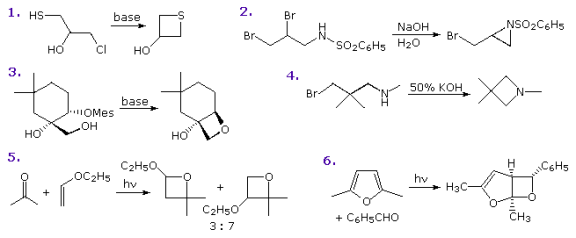
Reactions
The effect of ring strain can also be seen in reactions involving four-membered heterocycles. In the diagram below, some examples are given. As seen in examples 1, 2 and 3a, acid catalysis is a typical feature of many ring-opening reactions. In the thietane reaction (2), the sulphur is electrophilically chlorinated to form a chlorosulfonium intermediate, which is then substituted with a ring-opening chloride ion. As shown in reaction 3b, strong nucleophiles can also open the strained ether. Acid-catalyzed acyl exchange, as in 4a, or alkyl-O rupture by nucleophiles, as in 4b, are also possible cleavage reactions for -lactones. A fascinating case of intramolecular rearrangement to an ortho-ester is Example 5. Finally, the enhanced acylating reactivity of this fused ring mechanism is demonstrated by the -lactam cleavage of penicillin G (reaction 6). Because of p-resonance stabilization, most amides are highly unreactive acylation reagents. In penicillin’s, such electron pair delocalization is reduced, resulting in a pyramidal nitrogen structure and a more reactive carbonyl feature against nucleophiles.
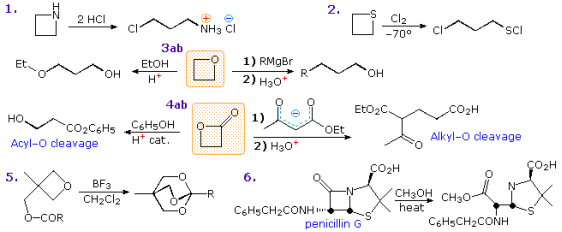
Q3) Explain Five-Membered Rings in Nomenclature.
A3)
Preparation
As shown in the uppermost equation below, commercial preparation of furan begins with the aldehyde furfural, which is generated from pentose-containing raw materials such as corncobs. The second-row equations show pyrrole and thiophene preparations that are similar. The Paal-Knorr synthesis, shown in the third row, is a general method for making substituted furans, pyrroles, and thiophenes from 1,4-dicarbonyl compounds. There has been a slew of other procedures that lead to substituted heterocycles of this kind. Reactions 2 and 3 demonstrate two of these. Palladium-catalyzed hydrogenation reduces furan to tetrahydrofuran. Not only is this cyclic ether a useful solvent, but it can also be easily converted into 1,4-dihalobutanes or 4-haloalkylsulfonates, which can be used to make pyrrolidine and thiolane.
Dipolar cycloaddition reactions often result in five-membered heterocycles with more complexity.
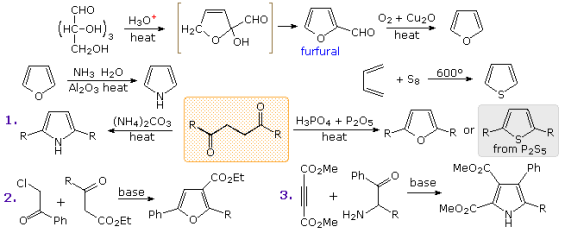
Indole is probably the most important fused ring heterocycle in this class. By clicking on the above diagram three examples of indole synthesis will be displayed. The first proceeds by an electrophilic substitution of a nitrogen-activated benzene ring. The second presumably takes place by formation of a dianionic species in which the ArCH2(–) unit bonds to the deactivated carbonyl group. Finally, the Fischer indole synthesis is a remarkable sequence of tautomerism, sigmatropic rearrangement, nucleophilic addition, and elimination reactions occurring subsequent to phenylhydrazone formation. This interesting transformation involves the oxidation of two carbon atoms and the reduction of one carbon and both nitrogen atoms.
Reactions
The chemical reactivity of the saturated members of this class of heterocycles: tetrahydrofuran, thiolane and pyrrolidine, resemble that of acyclic ethers, sulfides, and 2º-amines, and will not be described here. 1,3-Dioxolanes and dithiolanes are cyclic acetals and thioacetals. These units are commonly used as protective groups for aldehydes and ketones, and may be hydrolyzed by the action of aqueous acid.
It is the "aromatic" unsaturated compounds, furan, thiophene and pyrrole that require our attention. In each case the heteroatom has at least one pair of non-bonding electrons that may combine with the four π-electrons of the double bonds to produce an annulene having an aromatic sextet of electrons. This is illustrated by the resonance description at the top of the following diagram. The heteroatom Y becomes sp2-hybridized and acquires a positive charge as its electron pair is delocalized around the ring. An easily observed consequence of this delocalization is a change in dipole moment compared with the analogous saturated heterocycles, which all have strong dipoles with the heteroatom at the negative end. As expected, the aromatic heterocycles have much smaller dipole moments, or in the case of pyrrole a large dipole in the opposite direction. An important characteristic of aromaticity is enhanced thermodynamic stability, and this is usually demonstrated by relative heats of hydrogenation or heats of combustion measurements. By this standard, the three aromatic heterocycles under examination are stabilized, but to a lesser degree than benzene.
Additional evidence for the aromatic character of pyrrole is found in its exceptionally weak basicity (pKa ca. 0) and strong acidity (pKa = 15) for a 2º-amine. The corresponding values for the saturated amine pyrrolidine are: basicity 11.2 and acidity 32.
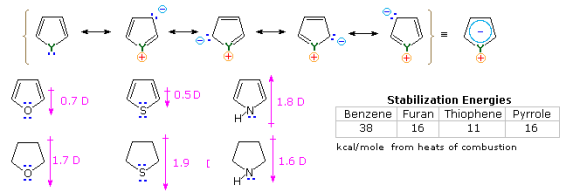
Aromatic systems also have a pattern of reactivity with electrophilic reagents, which is particularly important to chemists. Simple cycloalkenes are more likely to react by addition, while aromatic compounds are more likely to react by substitution. These substitutions occur by an initial electrophile addition, followed by a proton loss from the "onium" intermediate to regenerate the aromatic ring, as seen with benzene and its derivatives. Electrophilic substitution occurs in all aromatic five-membered heterocycles, with the following reactivity order: pyrrole >> furan > thiophene > benzene. In the diagram below, some examples are given. The reaction conditions clearly indicate that furan has a higher reactivity than thiophene. All of these aromatic heterocycles react violently with chlorine and bromine, resulting in polyhalogenated materials that are often combined with polymers. The reaction of pyrrole with iodine (bottom left equation) and the formation of 2-acetylpyrrole by simply heating it with acetic anhydride demonstrate its exceptional reactivity (no catalyst).
Q4) Explain Properties of six-Membered Rings in Nomenclature.
A4)
Properties
The reactivity of the saturated members of this class of heterocycles, such as tetrahydropyran, thiane, and piperidine, is similar to that of acyclic ethers, sulphides, and 2o-amines, and will not be discussed further. Dithianes and 1,3-dioxanes are cyclic acetals and thioacetals, respectively. These units are widely used as defensive groups for aldehydes and ketones, as well as synthetic intermediates, and are susceptible to aqueous acid hydrolysis. The interaction between the double bond and the heteroatom determines the reactivity of partially unsaturated compounds (e.g., 3,4-dihydro-2H-pyran is an enol ether).
The aromatic rings of completely unsaturated six-membered nitrogen heterocycles like pyridine, pyrazine, pyrimidine, and pyridazine are stable. As in the case of 2,4,6-triphenylpyrylium tetrafluoroborate, oxygen and sulphur analogues are still positively charged.

Electrophilic Substitution of Pyridine
Pyridine is a relatively weak base (pKa=5.2). Pyridinium species formed by N-substitution retain the aromaticity of pyridine because the basic unshared electron pair is not part of the aromatic sextet, as it is in pyrrole. In the absence of water or other reactive nucleophiles, N-alkylation and N-acylation products can be prepared as stable crystalline solids, as shown below. N-acyl salts can be used as acyl transfer agents when making esters and amides. The pyridinium cation has been used as a moderating factor in complexes with a variety of reactive inorganic compounds due to its stability. At the bottom of the diagram, there are some examples of these safe and easy-to-handle reagents. The tribromide salt is a convenient source of bromine, and the poly (hydrogen fluoride) salt is a convenient source of HF for addition to alkenes and conversion of alcohols to alkyl fluorides. Pyridinium chlorochromate (PCC) and its associated dichromate analogue are versatile oxidation agents, and the tribromide salt is a convenient source of HF for addition to alkenes and conversion of alcohols to alkyl fluor Similarly, the reactive compounds sulphur trioxide and diborane can be treated as pyridine complexes with ease and safety.
Other Reactions of Pyridine
Pyridine compounds are more susceptible to nucleophilic substitution reactions than similar benzene derivatives due to the nitrogen in the ring. Reaction 1 depicts the replacement of a 2-chloro substituent by an ethoxide anion in the following diagram. The ability of nitrogen to support a negative charge aids the addition-elimination process shown for this reaction. While a similar intermediate may be written for the substitution of a 4-halopyridine, the lack of such an intermediate prevents substitution at the 3-position. The leaving anion in reactions 2 and 3 of the Chichibabin aminations is hydride, which is unusual (or an equivalent). During these reactions, hydrogen is frequently produced. Quinoline is aminated at both C-2 and C-4 according to this process.
As shown by reactions 4 and 5, adding strong nucleophiles to N-oxide derivatives of pyridine proceeds more quickly than adding strong nucleophiles to pyridine itself. By removing the –OM substituent on nitrogen, the dihydro-pyridine intermediate quickly loses water or its equivalent.
Q5) Define Amines and Explain its Classification.
A5)
Amines are a class of organic compounds that are formed by replacing one or more hydrogen atoms in a molecule of ammonia with an alkyl or aryl group. Vitamins, proteins, hormones, and other substances contain them. They're used in the production of a wide range of drugs and detergents.
Classification of amines:
Amines are graded as primary (1o), secondary (2o), or tertiary (3o) depending on how many hydrogen atoms are substituted by an alkyl or aryl group in ammonia (3o). Amines of the type R-NH2 or primary amines (1o) are obtained when only one hydrogen atom is substituted. Secondary amines are formed when two of the three hydrogen atoms are replaced by alkyl/aryl groups. Tertiary amines are formed when all three hydrogen atoms are replaced by an alkyl/aryl ring.
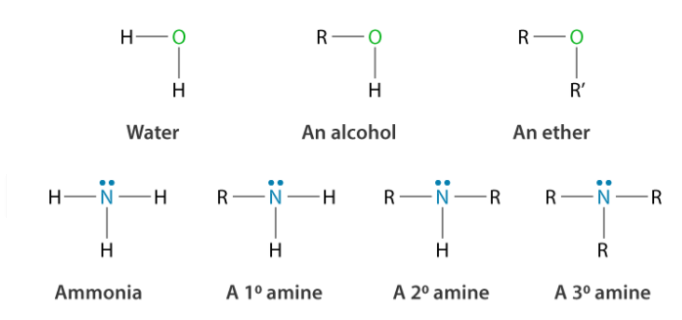
Q6) Explain Nomenclature of Amines.
A6)
The names of compounds that are globally recognized in organic chemistry are given according to the IUPAC guidelines for organic compound nomenclature. Aliphatic amines are named by adding an alkyl group to the end of the amine, so their names are in the form of alkylamine. Methylamine is the name given to CH3NH2 (alkyl component + amine = methylamine). If two or more equivalent groups are present, prefixes such as di and tri are added before the names of the alkyl groups. If the amine contains more than one amino group, the parent chain and amino group positions are determined by counting the carbon atoms in the parent chain. The carbon atoms with the –NH2 groups are given the lowest numbers in the numbering system. The number of amino groups and their position in the molecule are then denoted by prefixes and numbers. Ethane 1, 2-diamine, for example, is designated as H2N-CH2-CH2-NH2.
Arylamines are formed when a –NH2 group is added to a benzene bond.
C6H5NH2 is one of the most basic examples of arylamine. It's also known as aniline, which is a recognized IUPAC name. When we call arylamines according to the IUPAC guidelines, the arene's e is substituted by amine, for example, C6H5-NH2 is called benzamine.
Q7) Give the Classification of Alkyl Halides.
A7)
The bonding patterns of the atoms involved are used to classify functional groups. Halogens have only one neutral bonding pattern (three lone pairs and a single bond), so their classification cannot be determined by them. The bonding pattern of the carbon bound to the halogen is used to assess the classification of alkyl halides, as shown in the diagram below.
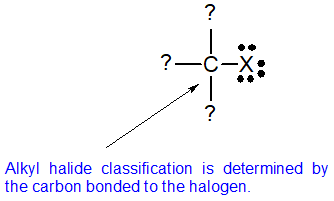
Alkyl halide classification is determined by the carbon bonded to the halogen
● Primary alkyl halides
The carbon carrying the halogen atom is only bound to one other alkyl group in a primary (1°) halogenoalkane. The following are some examples of primary alkyl halides:

It's worth noting that the complexity of the attached alkyl group has no impact. There is only one connection to an alkyl group from the CH2 group that holds the halogen in each case. Even if there are no alkyl groups attached to the carbon with the halogen on it, CH3Br and the other methyl halides are often counted as primary alkyl halides.
● Secondary alkyl halides
The carbon with the halogen attached is joined directly to two other alkyl groups, which may be the same or different, in a secondary (2°) halogenoalkane. Consider the following examples:

● Tertiary alkyl halides
The carbon atom carrying the halogen is directly connected to three alkyl groups in a tertiary (3°) halogenoalkane, which can be any mixture of same or different. Consider the following examples:

Q8) Explain the Five-membered ring containing one heteroatom.
A8)
The structures of the parent aromatic compounds in this family—pyrrole, furan, and thiophene—are seen.

Pyrolidine, tetrahydrofuran, and thiophane are the saturated derivatives, respectively. The bicyclic compounds indole (or isoindole), benzofuran, and benzothiophene are made up of a pyrrole, furan, or thiophene ring fused to a benzene ring, respectively.
The nitrogen heterocycle pyrrole, as stated in the introduction, is found in bone oil and is produced by the decomposition of proteins when heated to high temperatures. The amino acids proline and hydroxyproline, which are components of several proteins and are contained in especially high amounts in collagen, the structural protein of bones, tendons, ligaments, and skin, contain pyrrole rings.
Pyrrole derivatives can be found all over the living world. Alkaloids, a broad class of alkaline organic nitrogen compounds formed primarily by plants, include pyrrole compounds. The most well-known pyrrole-containing alkaloid is nicotine. The heme group of the oxygen-carrying protein haemoglobin and associated compounds such as myoglobin; the chlorophylls, which are light-gathering pigments found in green plants and other photosynthetic organisms; and vitamin B12 are all made up of four pyrrole units linked together in a larger ring structure known as a porphyrin, such as chlorophyll b, shown below.
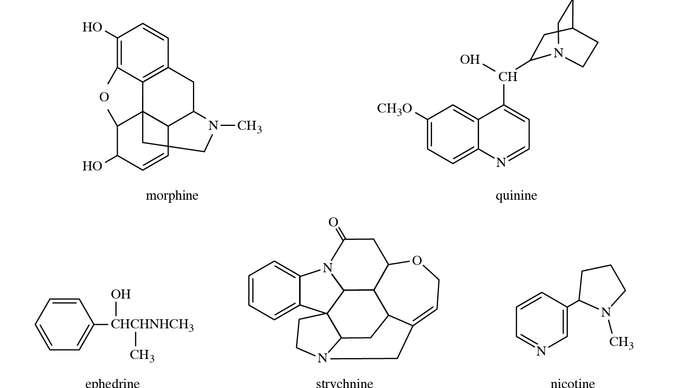
Q9) Explain the Six-membered rings with one heteroatom.
A9)
The following is the nomenclature for the various monocyclic nitrogen-containing six-membered ring compounds. The positions of pyridine on the ring are shown, with Arabic numerals preferred over Greek letters, though both systems are used. Since contributions to the resonance hybrid from charged resonance forms, such as that seen for 4-pyridone, the pyridones are aromatic compounds.

Picolines, lutidines, and collidines are mono-, di-, and trimethylpyridines—that is, pyridines with one, two, or three attached methyl groups, respectively—with the position of the methyl groups denoted by numbers—e.g., 2,4,6-collidine. Picolinic, nicotinic (derived from nicotine, of which it is an oxidation product), and isonicotinic acid are all common names for pyridine-2-, -3-, and -4-carboxylic acids. Coal tar and bone oil contain pyridine, as well as picolines, lutidines, and collidines. Pyridine derivatives are also very important in biology. For example, nicotinic acid is more generally known as the B-complex vitamin niacin; nicotinamide, or niacinamide, is a nutritionally similar type of niacin. Pyridoxine, or vitamin B6, is another member of the B complex. Pyridoxine and nicotinamide have the following structures:

Nicotinamide adenine dinucleotide (NAD, also called coenzyme I) and nicotine adenine dinucleotide phosphate (NADP, coenzyme II) are two coenzymes derived from nicotinamide, and pyridoxal phosphate (codecarboxylase) is a physiologically active type of pyridoxine. Many alkaloids, including nicotine (mentioned in the previous section for its pyrrole ring) and piperine (one of the sharp-tasting constituents of white and black pepper, from the plant species Piper nigrum), have pyridine or piperidine ring structures, as shown.

Pyridine is an essential solvent and intermediate used to produce other compounds. It was once extracted commercially from coal tar but is now made catalytically from tetrahydrofurfuryl alcohol and ammonia. Vinylpyridines, for example,

Completely saturated pyridine, piperidine, is used in rubber manufacturing and as a chemical raw material, and is an effective monomer building block for plastics.
Q10) Explain the Mechanism of the Paal-Knorr Furan Synthesis.
A10)
● Mechanism of the Paal-Knorr Furan Synthesis

The cyclization rates of meso- and dl-3,4-diethyl-2,5-hexanediones were compared, and it was discovered that the stereochemical structure of the unchanged dione was retained during the reaction. These results contradict the widely accepted mechanism, which requires the ring closure of a rapidly formed monoenol, as seen here.

The rate of acid-catalyzed enolization is considered to be unaffected by the ketone's structure. The variations in reaction rate cannot be explained by this mechanism since the rate-determining phase is the same for both substrates.
Below is a diagram of how the substituents will interact differently in the rate-determining phase. The ease with which both molecules can achieve a suitable conformation for cyclization is not the same:

Q11) Explain the Paal-Knorr Pyrrole Synthesis and its Mechanism.
A11)
Paal-Knorr Pyrrole Synthesis

The Paal-Knorr Pyrrole Synthesis produces pyrrole by combining a 1,4-dicarbonyl compound with an excess of a primary amine or ammonia.
Under neutral or weakly acidic conditions, the reaction can be carried out. The use of a weak acid, such as acetic acid, speeds up the reaction, but amine/ammonium hydrochloride salts or reactions at pH 3 result in furans as the main product (Paal-Knorr Furan Synthesis).
● Mechanism of the Paal-Knorr Pyrrole Synthesis

Venkataraman Amarnath demonstrated that meso- and dl-3,4-diethyl-2,5-hexanediones cyclize at different rates and that the stereochemical structure of the unchanged dione is retained during the reaction (J. Org. Chem., 1991, 56, 6924). Any process involving the creation of an enamine prior to the rate-determining phase of cyclization, such as the one below, must be ruled out.
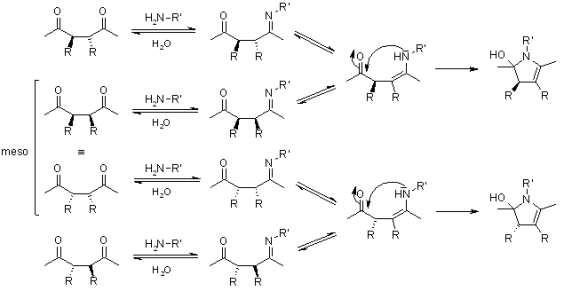
A charged immonium ion must be an intermediate if the ring is produced from an imine created from a primary amine. Amarnath used various aryl groups as substituents to stabilize or destabilize the immonium ion:

The use of ammonia can result in an uncharged intermediate, which is less influenced by the substituents used. The basicity of the imine is also influenced by the substituents, with the nitro group resulting in a more specific nucleophile. Ammonia and methylamine were used to compare cyclization rates. The nitro group has had a positive impact on the reaction rate in any case. In each case, the methoxy group has a negative effect on the cyclization rate. For a potential mechanism involving an immonium ion, a comparison of the relative reaction rates of all substrates (R: H, Me) revealed no clear stabilization/destabilization effect.
The cyclization of a hemiacetal, accompanied by different dehydration steps, is a process that accounts for the effect of different substitution patterns (meso, dl) and explains the influence of a p-nitrophenyl group making a nucleophile more reactive (but not as the imine):
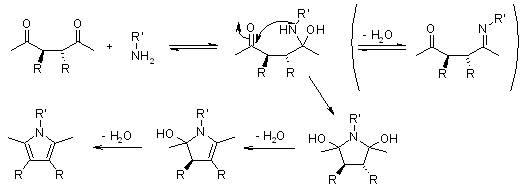
Q12) Explain Paal-Knorr Pyrrole Synthesis.
A12)
- The Paal-Knorr Thiophene Synthesis involves the condensation of a 1,4-dicarbonyl compound in the presence of an excess of a sulphur source, such as phosphorous pentasulfide or Lawesson's reagent, to produce thiophenes. Attention: regardless of the sulphur source, some toxic H2S forms as a by-product.
- The Paal-Knorr Pyrrole Synthesis produces pyrrole by combining a 1,4-dicarbonyl compound with an excess of a primary amine or ammonia. Under neutral or weakly acidic conditions, the reaction can be carried out.
- In organic chemistry, the Paal–Knorr Synthesis is a reaction that produces furans, pyrroles, or thiophenes from 1,4-diketones. It's a useful method for synthesising substituted furans and pyrroles, which are common structural elements in many natural products.
Q13) What is Hantzsch Dihydropyridine (Pyridine) Synthesis? Explain its Mechanism.
A13)
Hantzsch Dihydropyridine (Pyridine) Synthesis
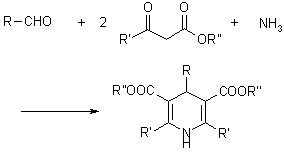
The condensation of an aldehyde with two equivalents of a -ketoester in the presence of ammonia makes the preparation of dihydropyridine derivatives. Following oxidation (or dehydrogenation), pyridine-3,5-dicarboxylates are formed, which can then be decarboxylated to yield pyridines.
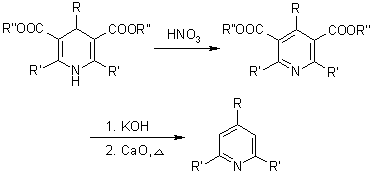
● Mechanism of the Hantzsch Dihydropyridine Synthesis
As a main intermediate, the reaction can be visualized as passing through a Knoevenagel Condensation product:

The ester enamine, which is formed by condensation of the second equivalent of the -ketoester with ammonia, is a second important intermediate:

The dihydropyridine derivative is formed by further condensation between these two fragments:
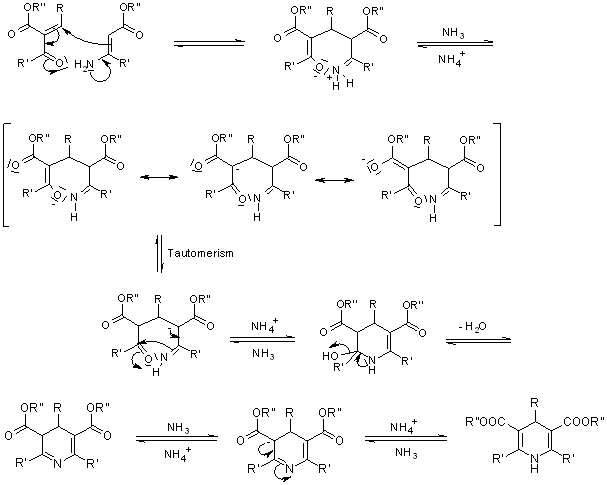
Q14) Explain Paal Thiophene Synthesis and its Mechanism.
A14)
Paal Thiophene Synthesis

The Paal-Knorr Thiophene Synthesis involves the condensation of a 1,4-dicarbonyl compound in the presence of an excess of a sulphur source, such as phosphorous pentasulfide or Lawesson's reagent, to produce thiophenes.
Attention: regardless of the sulphur source, some toxic H2S forms as a byproduct.
● Mechanism of the Paal-Knorr Thiophene Synthesis
Phosphorus pentasulfide or Lawesson's reagent function as both sulfurizing and dehydrating agents, allowing for a reaction pathway that could lead to the formation of furans first. Foye (J. Org. Chem., 1952, 17, 1405) tested this hypothesis by treating various 1,4-dicarbonyl compounds and their possible furan intermediates (such as acetonylacetone and 2,5-dimethylfuran) with phosphorus pentasulfide. The disparities in 2,5-dimethylthiophene yields under the same reaction conditions rule out the possibility of a dominant reaction pathway involving furan intermediates:
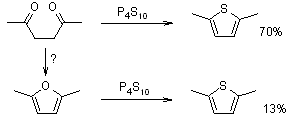
Foye suggested the following reaction pathway:

The presence of a bis-thioketone intermediate is now thought to be possible but not needed (J. Schatz, Science of Synthesis, George Thieme Verlag Stuttgart, 2000, Vol. 9, 298.)

Q15) What is Fischer Indole Synthesis? Explain Its Reaction.
A15)
Both organic and medical chemists and medicinal chemists have found enough opportunities in indole synthesis. Thousands of indole derivatives are generated each year in the quest for life-saving drugs.
Fischer invented the Fischer indole synthesis in 1883, and it is one of the oldest and most powerful methods of indole growth. In the presence of Brnsted or Lewis acids, a number of indoles may be made from aryl hydrazines and substituted ketones or aldehydes.
The Fischer indole synthesis, in which an aromatic phenylhydrazone is heated in acid, is the most useful route to indoles. The condensation product of a phenylhydrazine and an aldehyde or ketone is phenylhydrazone. A cyclic rearrangement mechanism is used to close the ring.
Fischer Indole Synthesis Reaction:
Since Emil Fischer's discovery of the Fischer indole synthesis in 1883, it has become the most widely used method for preparing indole rings. In essence, the Fischer indole synthesis is the cyclization of an arylhydrazone, which is formed by treating an aryl hydrazine with an aldehyde or a ketone with an acid catalyst or by heating it to form the indole nucleus. For over a century, scientists have been studying the process in depth, and several intermediates have been isolated and characterized.
Below is the Fischer indole synthesis reaction.

Indole synthesis has possibly received more attention than any other single heterocyclic method, and as a result, several routes are available; ring syntheses of benzo furans and benzo thiophenes, on the other hand, have received much less attention. The Fischer indole synthesis, which has been around for over a century, is still commonly used: an aryl hydrazone is heated with an acid, a multi-step sequence follows, ammonia is lost, and an indole is generated.
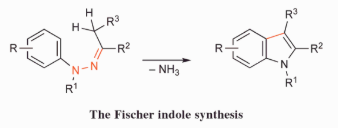
The synthesis is often carried out by directly idolizing an equimolar mixture of aryl hydrazine and aldehyde or ketone without first isolating the hydrazone. Similarly, aryl hydrazones prepared by reduction of the corresponding aryldiazonium salt or N-nitroso arylalkylamine or by a palladium-mediated coupling reaction can be indolized directly in the presence of the carbonyl moiety without isolation of the aryl hydrazone. When the aryl hydrazone intermediates are unstable or toxic, such methods are useful.
Q16) Explain Fischer Indole Synthesis Reaction Mechanism.
A16)
The enamine lautomer is formed by protonation and isomerization of the arylhydrazone formed by condensation of an aryl hydrazine and a carbonyl compound. The protonated enamine lautomer then undergoes an irreversible [3,3] – sigmatropic electrocyclic rearrangement, in which the N-N bond is broken.
The benzene ring is then re-aromatized by the resulting double imine, yielding an anilino imine, whose nucleophilic amine group attacks the imine intramolecularly to yield the amino indoline. The indole is generated after the loss of an ammonia molecule and aromatization.
As hydrazine reacts with a carbonyl compound, it behaves like an amine and produces a hydrazone, which is an imine-like substance. The enamine tautomer of this hydrazone undergoes the cycle rearrangement, which occurs because the cyclic movement of electrons creates a tight C-C bond thus cleaving a weak N-N bond. This seems to be the formation of a di-imine.
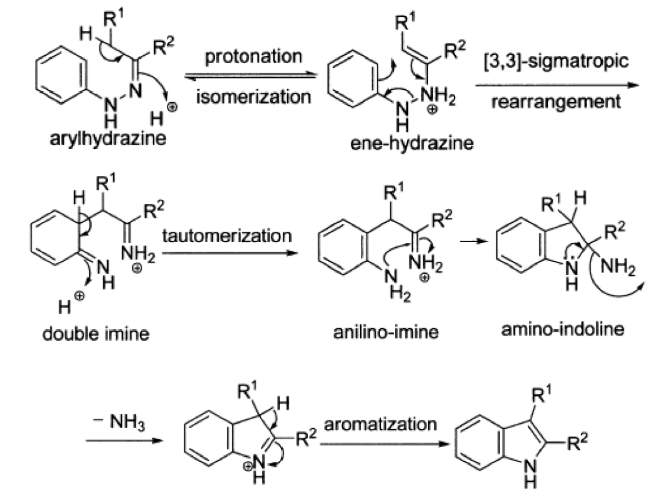
The rearomatization of one of these results in the formation of nan aromatic amine. The other imine feature is then attacked, yielding the nitrogen equivalent of a hemiketal. Finally, the aromatic indole system is formed by ammonia elimination catalysed by an acid.
Q17) Explain the Drawbacks and the Features of Fischer Indole Synthesis.
A17)
Unfortunately, the reaction fails when acetaldehyde is used, so it can't be used to make indole. Instead, you can use the keto acid pyruvic acid and decarboxylate the result to get indole.

Features of Fischer Indole Synthesis
- The Fischer Indole Synthesis has the following main features: The indole formation can be achieved in a single pot because the intermediate arylhydrazonesx do not need to be separated.
- Unsymmetric ketones produce two region-isomeric 2,3-displaced indols with a region-selectivity that is influenced by medium acidity, hydrazine substitution, and steric effects.
- 1,2-diketones may produce mono- and bis-indoles, which are typically formed in refluxing alcohols by strong acid catalysts.
- 3.6.6 Mechanism of the Madelung Indole Synthesis
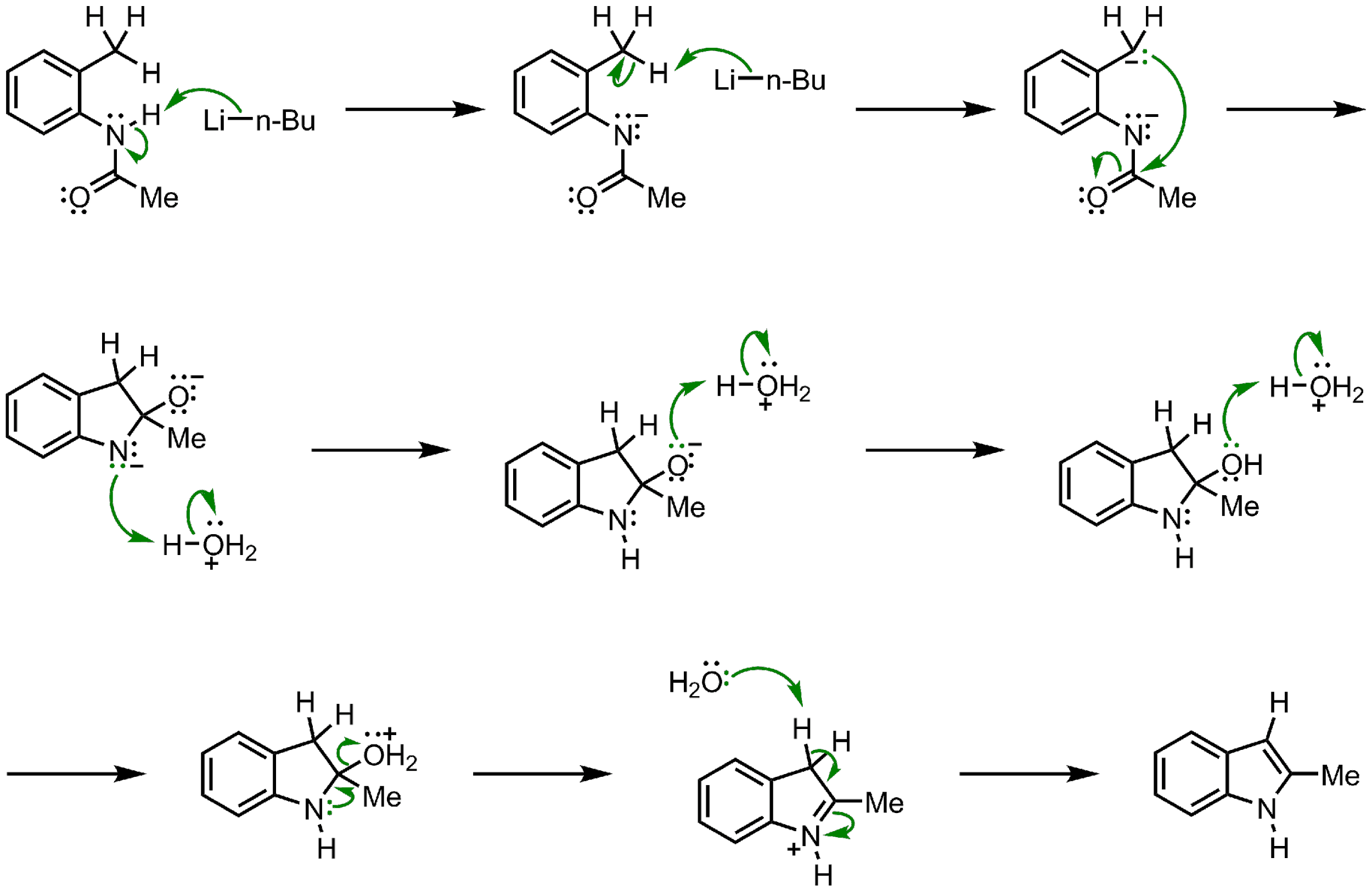
Q18) Explain the Preparation of Furfural Acid.
A18)
● Preparation:
Furfural may be obtained by the acid catalyzed dehydration of 5-carbon sugars (pentoses), particularly xylose.

These sugars can be made from pentosans, which are found in lignocellulosic biomass as hemicellulose.
Depending on the form of feedstock, between 3% and 10% of the mass of crop residue feedstocks can be recovered as furfural. Furfural and water detach from the reaction mixture as they evaporate and condense. As of 2012, the global production capacity was about 800,000 tonnes. China is the world's largest supplier of furfural, with the majority of global capacity. Illovo Sugar in South Africa and Central Romana in the Dominican Republic are the other two major commercial producers.
Furfural can be made from plant material in the lab by heating it with sulfuric acid or other acids. A worldwide effort to replace sulfuric acid with easily-separable and reusable solid acid catalysts has been studied in order to prevent poisonous effluents.
After the furfural is removed in industrial processing, some lignocellulosic residue remains. This residue is dried and burned to generate steam for the furfural plant's activity. Excess residue from newer, more energy efficient plants is or can be used for co-generation of electricity, cattle feed, activated carbon, mulch/fertilizer, and other purposes.
Q19) Explain the Preparation of Furoic Acid and its advantages.
A19)
● Preparation:
The oxidation of either furfuryl alcohol or furfural produces 2-furoic acid. This can be accomplished chemically or by biocatalysis. The Cannizaro reaction of furfural in an aqueous NaOH solution is currently the industrial path, which produces both 2-furoic acid and furfuryl alcohol. [5] The microorganism Nocardia corallina is involved in the bio-catalytic pathway. Experiments with this microbial conversion yielded high yields: 98 percent from 2-furfuryl alcohol and 88 percent from 2-furanaldehyde, respectively. Because most other microorganisms create two products from oxidation, the acid and the alcohol, N. Corallina's oxidation is special. Furthermore, there is no aromatic ring destruction.

Biotransformation of furfuryl alcohol (R = CH2OH) or furfural (R = CHO) to 2-furoic acid by Nocardia corallina
Advantages
- 2-Furoic acid is an organic compound used as a preservative and flavouring agent in food products. Nylon preparation and optic technologies are two other applications for 2-furoic acid.
- Inks, plastics, antacids, adhesives, nematicides, fungicides, fertilisers, and flavouring compounds are all made with furfural [60]. Furfural is a solvent that can also be used to make furfuryl alcohol, tetrahydrofuran (THF), and levulinic acid (LA).
- 2-Furoic acid is a heterocyclic carboxylic acid with a carboxylic acid group and a five-membered aromatic ring. Its name comes from the Latin word furfur, which means "bran."
- Contact with the skin, eyes, and mucous membranes may cause irritation. Ingestion and skin touch can be harmful, and inhalation can be mildly toxic. A furan with a hydroxymethyl substituent at the 2-position is known as furfuryl alcohol. It plays a part in the Maillard reaction.